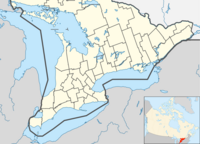Hillsburgh, Ontario
| Erin | ||
|---|---|---|
| Town (lower-tier) | ||
| Town of Erin | ||
|
||
 Location of Erin within Wellington County |
||
| Location of Erin within southern Ontario | ||
| Coordinates: 43°46′N 80°04′W / 43.767°N 80.067°WCoordinates: 43°46′N 80°04′W / 43.767°N 80.067°W | ||
| Country |
|
|
| Province |
|
|
| County | Wellington | |
| Established | 1820 | |
| Amalgamated | 1997 | |
| Government | ||
| • Mayor | Allan Alls | |
| • Governing Body | Town of Erin Council | |
| • MP | Mike Chong (Con) | |
| • MPP | Ted Arnott (PC) | |
| Area | ||
| • Town (lower-tier) | 297.75 km2 (114.96 sq mi) | |
| • Urban | 4.77 km2 (1.84 sq mi) | |
| Population (2011) | ||
| • Town (lower-tier) | 10,770 | |
| • Density | 36.2/km2 (94/sq mi) | |
| • Urban | 2,674 | |
| • Urban density | 560.6/km2 (1,452/sq mi) | |
| Time zone | EST (UTC-5) | |
| • Summer (DST) | EDT (UTC-4) | |
| Postal Code FSA | N0B | |
| Area code(s) | 519 | |
| Website | www.erin.ca | |
Erin is a town in Wellington County, approximately 80 kilometres (50 mi) northwest of Toronto, Ontario, Canada. Erin is an amalgamated town, composed of the former Villages of Erin and Hillsburgh, and the hamlets of Ballinafad, Brisbane, Cedar Valley, Crewson's Corners, Ospringe, and Orton, as well as the former Township of Erin. Erin's Town Council includes a Mayor (Allan Alls, 2014-2018) and four councillors. Its upper tier government is provided by Wellington County.
Erin is primarily a rural community but, while farming is still an important activity in the town, most of its population works in the nearby cities of Brampton, Mississauga, Guelph, and even Toronto. The town's new industrial park is attracting a number of new industries, due to its cheaper tax rate, accessibility to transportation, and its location within the "Technology Triangle," a series of high-tech driven cities including nearby Kitchener. Waterloo, and Cambridge.
The community not for profit organization is East Wellington Community Services.
A settlement developed after mills were built on the Credit River between 1826 and and 1829. The first settlers included Daniel MacMillan and the Trout family. The settlement was established as "MccMillan's Mills" although most sources indicate that the Trout family built the first sawmill. Even so, Daniel MacMillan and his brothers are acknowledged as significant contributors to the growth of the village.
By 1839 a post-office opened, and in 1849, the first place of worship, the Union Church was being used by several denominations. Previously, services had been held in homes and in other available buildings. By 1851, the population increased to 300; the name of the settlement was Erinsville at the time but was later shortened to Erin. Businesses in the area included a distillery, a tannery, and carding, oatmeal and grist-mills. The river provided the power for mills, helping to boost agriculture, milling and wood products manufacturing. The Credit Valley Railroad reached Erin in 1879 and the same year, Erin was incorporated as a village. At the time the population was 750.
Electricity from small private providers became available before 1890 and a formal power company was established in 1900, Cataract Light & Power. Hydro power was generated at Cataract; that facility was sold to Ontario Hydro in 1944 and continued to operate until 1947.
...
Wikipedia


